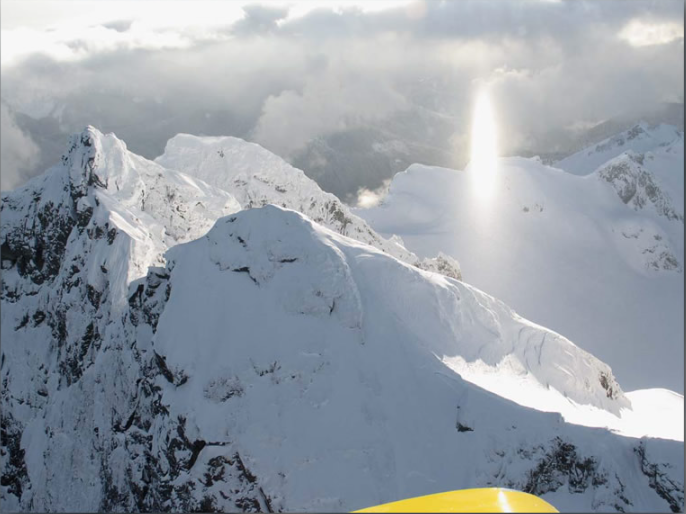Subsun
The Enigmatic Subsun: A Fascinating Atmospheric Phenomenon
Have you ever looked out of an airplane window and been captivated by a blinding, shimmering disk or oval floating alongside the aircraft? This intriguing sight is known as a subsun, a mesmerizing ice halo that forms through the reflection of sunlight from plate crystals in the atmosphere. In this article, we will delve deeper into the enigmatic subsun and explore its formation, characteristics, and the mesmerizing visual spectacle it presents.
Unveiling the Formation of the Subsun
The subsun is created when sunlight reflects off both the upper and lower nearly horizontal faces of plate crystals suspended in the atmosphere. These ice crystals act as countless tiny mirrors, collectively forming a reflected image of the sun. When these crystals experience larger wobbles from their horizontal position, the subsun transforms into a lower sun pillar. This captivating phenomenon occurs when the sun is low on the horizon and the aircraft passes through diamond dust ice crystals, which further enhances the visual spectacle.
Observing the Subsun: A Bewitching Display
To witness the subsun in all its glory, one must direct their gaze towards the sunward side of an aircraft, focusing on clouds or mist. As the plane glides above the clouds or landscape, the subsun can be seen drifting alongside, creating an ethereal ambiance. However, it is important to note that despite its seemingly tangible presence, the subsun, like other halos and rainbows, is merely an optical illusion with no physical existence.
Exploring the Subsun's Appearance and Characteristics
The subsun often manifests as a blinding and shimmering disk or oval, captivating onlookers with its radiant glow. Its appearance can vary depending on atmospheric conditions and the angle of the sunlight. When observed from an airplane, this halo appears to hang suspended in the air, lending an almost magical aura to the surrounding scenery.
The Subsun's Mystical Connection to Plate Crystals
The key players in the formation of the subsun are the plate crystals. These delicate ice crystals, resembling tiny flat plates, are responsible for reflecting sunlight and creating the mesmerizing display. When the sunlight interacts with these crystals, it undergoes multiple reflections, resulting in the formation of the subsun. The size and orientation of the plate crystals play a crucial role in determining the characteristics of the subsun, adding to its intrigue.
Unraveling the Subsun's Winter Splendor
While the subsun can be observed throughout the year, it is particularly prevalent during winter when diamond dust ice crystals fill the air. These tiny ice crystals, resembling diamond particles, create a stunning backdrop for the subsun's appearance. As the winter sun hangs low on the horizon, casting its golden glow, the subsun emerges as a radiant spectacle against the icy landscape, leaving observers in awe of its winter splendor.
The Science Behind Atmospheric Optics
The study of atmospheric optics unravels the mysteries behind various optical phenomena that occur in the Earth's atmosphere. From halos and rainbows to mirages and auroras, these captivating displays are a result of the interaction between sunlight and atmospheric particles. By understanding the science behind these phenomena, scientists can gain insights into atmospheric conditions and contribute to meteorological research.
In conclusion, the subsun stands as a captivating atmospheric phenomenon that leaves spectators spellbound with its shimmering radiance. Formed through the reflection of sunlight from plate crystals, this optical illusion creates a dazzling spectacle that can be observed from aircraft windows. As we continue to unravel the secrets of atmospheric optics, the subsun remains an enigmatic beauty, showcasing the wonders of nature's optical intricacies. So next time you find yourself on a flight, don't forget to cast your gaze upon the sunward side of the aircraft and witness the mesmerizing subsun floating alongside, adding a touch of magic to the skies.

Subsun pictured in winter by John Scurlock (photo galleries) over Three Fingers in the North Cascades Range, Washington State. Image ©John Scurlock
The subsun can often be seen from an airplane as a blinding and shimmering disk or oval. Look down on sunward side of the aircraft at clouds or mist to see it drifting with the 'plane over the clouds or landscape.
The subsun is an ice halo formed by reflection of sunlight from the upper and lower nearly horizontal faces of plate crystals. The crystals act as millions of tiny mirrors to form a reflected image of the sun. When the crystals have larger wobbles from horizontal the subsun becomes a lower sun pillar.
Here the sun is low and the small aircraft is actually flying through diamond dust ice crystals. The resulting subsun seemingly hangs in the air but of course, like all halos and rainbows, it has no corporeal existence.

Note: this article has been automatically converted from the old site and may not appear as intended. You can find the original article here.
Reference Atmospheric Optics
If you use any of the definitions, information, or data presented on Atmospheric Optics, please copy the link or reference below to properly credit us as the reference source. Thank you!
-
<a href="https://atoptics.co.uk/blog/subsun-2/">Subsun</a>
-
"Subsun". Atmospheric Optics. Accessed on November 26, 2024. https://atoptics.co.uk/blog/subsun-2/.
-
"Subsun". Atmospheric Optics, https://atoptics.co.uk/blog/subsun-2/. Accessed 26 November, 2024
-
Subsun. Atmospheric Optics. Retrieved from https://atoptics.co.uk/blog/subsun-2/.